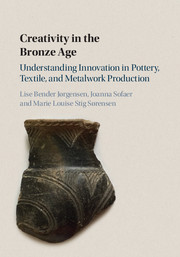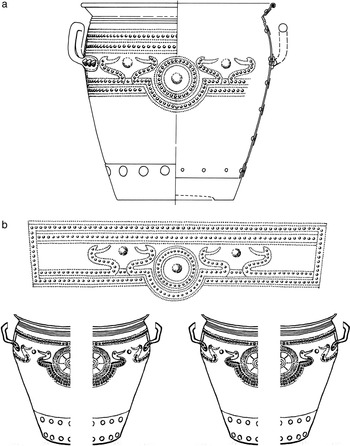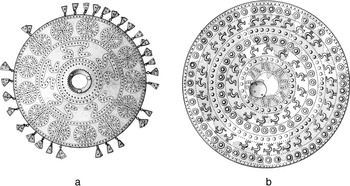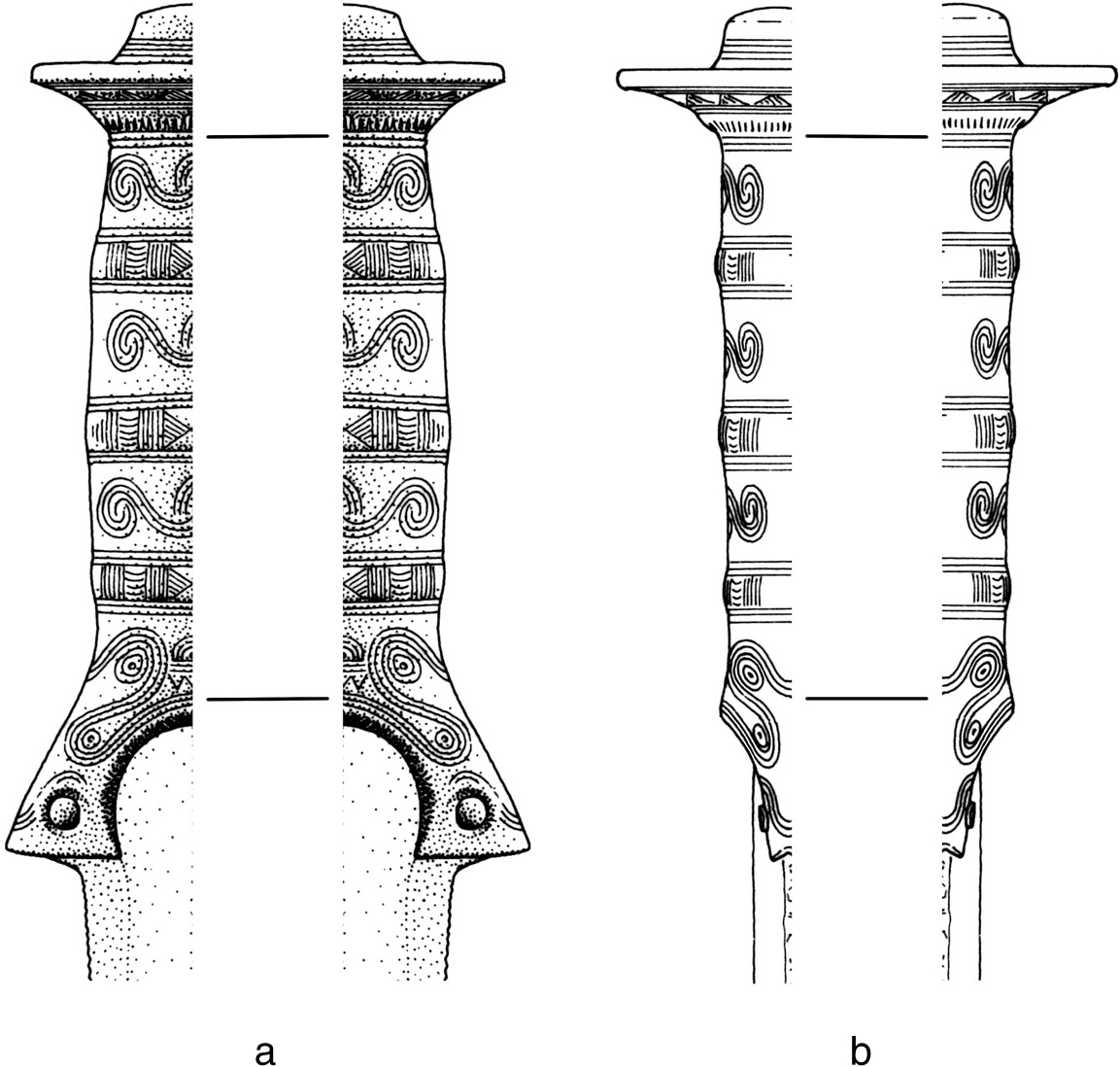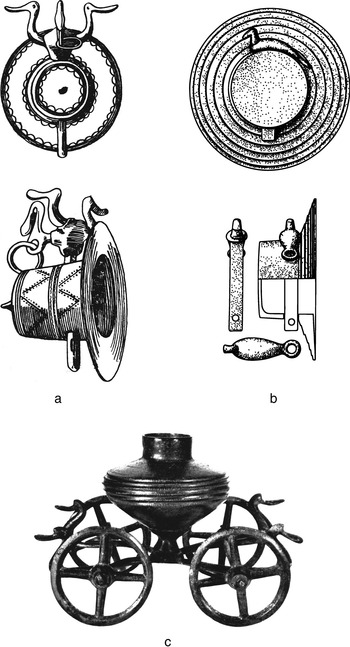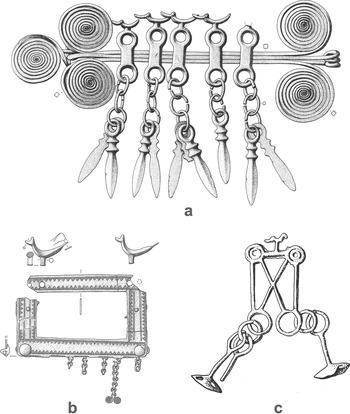The body and the material world emerge and decay – they are unstable – what is stable, however, are the cosmological principles, which structure the world. To say something is present and yet absent is to understand this absence in terms of physical and visual co-presence. Ancestors, the dead, cosmology, and God are most emphatically present, but not apprehended in terms of visual and physical co-presence that the term ‘absent presence’ signifies. As a result, various complex technologies have been devised which are commonly glossed as ‘ritual activity’ to presence these entities in a given material register, which in another context, say the colloquial empirical, might be thought of as ‘absent’.
This quote by Victor Buchli summarises the paradoxical nature of religious belief: based on immaterial principles, it can only be experienced in the here and now. Thus material culture plays an important role in the articulation of religious ideas, by giving them an experiential dimension. This, however, is a challenging affair; for such material culture needs to overcome its own materiality in order to presence religious contents. As Birgit Meyer (Reference Meyer2008: 132) has recently argued, religious objects need to ‘invoke a sense of the divine as present in – and at the same time surpassing – the forms through which it is to be accessed’.
The notion of creativity provides a useful way to reconceptualise this constitutive role of material culture in religious discourse. Creative action may be envisioned as the on-going engagement of people with materials, thus as the continuous transformation of matter into media. This view chimes closely with Tim Ingold and Elizabeth Hallam’s (Reference Ingold, Hallam, Hallam and Ingold2007: 11) idea of creativity as ‘a process that living beings undergo as they make their ways through the world’. From this perspective, creativity, as the dialectic relationship between people and the material world, plays a fundamental role in the mediation of cosmological knowledge. Indeed, it is creativity that resolves the tension between the presence of the divine and its material articulation, that is to say, the inherent paradox of materially experienced transcendence (Boivin Reference Boivin2009). In that sense, religious objects are creatively designed to combine religious ideas with particular sensory experiences. The objects thus created appeal to particular sensory registers, thereby lending sensory authenticity to immaterial principles. In a nutshell, creativity makes religion real.
Thus we may ask ‘how creative were Bronze Age cosmologies?’ If, as suggested, creativity is the process by which religious knowledge is transformed into sensory experience, then how did it underpin Bronze Age cosmologies? What sensory registers did it activate, what were the technologies of presencing the immaterial, in short, how was cosmological knowledge brought down to earth to become part of people’s being in the world?
To explore these issues further, this essay focuses on Late Bronze Age bird iconography on central European metalwork. During this period bird images were arguably the most significant figurative motif, as suggested by their widespread distribution throughout central and eastern Europe and their occurrence on different categories of artefacts, both as two-dimensional engravings/repoussé work and three-dimensional appliqués. That birds were cosmologically important in Bronze Age communities is suggested by their depiction as creatures guiding, accompanying, or pulling the sun across the sky. It thus seems that their cosmological significance revolved around ideas of solar movement, cyclicality and, quite possibly, a cyclical worldview (Guba and Szeverényi Reference Guba and Szeverényi2007: 88–95; Wirth Reference Wirth, Beck, Geuenich and Steuer2006: 559–61, Reference Wirth, Meller and Bertemes2010).
Metalwork and its design played an important role in the mediation of such ideas, and this essay suggests that the relationship between objects and motifs, best envisioned in terms of design choices, creatively materialised notions of cosmological movement in two different ways: the first, to which I shall refer as epitomic visualisation, brought cosmological information into a mnemonic format by creating a high degree of visual synchronicity between objects and bird motifs; in the second, design aimed at a different set of sensory registers, primarily the haptic and auditory, to presence cosmological notions revolving around movement. Both design trajectories illustrate the capacity of creativity, here understood as residing in the relationship between motifs and objects, to resolve the intrinsic tension, if not paradox, of materialising an ontology of eternal movement through the material limitations of artefact design.
From Birds on Bronzes to Material Transcendence
The archaeological literature has long drawn attention to the widespread distribution of bird iconography throughout Europe and its unique status as the most common figurative design throughout the later European Bronze Age (for example: Bouzek Reference Bouzek, Gediga and Piotrowska2000; Jockenhövel Reference Jockenhövel1974a, Reference Jockenhövel and Müller-Karpe1974b, Reference Jockenhövel1997; Kossack Reference Kossack1954, Reference Kossack1999; Matthäus Reference Matthäus1980, Reference Matthäus and Lorenz1981; Roes 1939/Reference Roes1940; Schauer 1988–Reference Schauer1989; Sprockhoff Reference Sprockhoff1954, Reference Sprockhoff1955; Vasić and Vasić Reference Vasić and Vasić2003; von Merhart Reference von Merhart1952). So far research has tended to concentrate on the question of its origins. Still seminal in this respect is Georg Kossack’s study, Studien zum Symbolgut der Urnenfelder- und Hallstattzeit Mitteleuropas (Reference Kossack1954), in which he suggested that bird imagery may have originated in eastern Europe, most probably in what is nowadays Hungary and Slovakia. More recently, a number of attempts have been made to locate the origins of Urnfield bird imagery outside Europe, focusing on possible connections with the eastern Mediterranean and Near East (Bouzek Reference Bouzek1985: 178–9; Ernst Reference Ernst1995: 28–52; Matthäus Reference Matthäus1980, Reference Matthäus and Lorenz1981). Somewhat surprisingly, however, there have been relatively few attempts to interpret its socio-religious significance. Kossack (Reference Kossack1954), for instance, was hesitant to interpret the material, stating in a single footnote that any interpretation would be uncertain and unfounded (Reference Kossack1954: 5, footnote 2). Alongside this rather pessimistic position, there has been a tendency to use textual/mythological sources to get access to the meaning behind bird representations. For instance, it has been argued that the latter may be related to the Greek Apollo cult, based on the formal correspondence between the bird wagon from Dupljaja Serbia, and the Homeric narrative of Apollo’s annual journey to the land of the Hyperboreans, using a wagon pulled by swans (Hänsel Reference Hänsel2003; Jockenhövel Reference Jockenhövel1997: 261–2; Sprockhoff Reference Sprockhoff1954: 67–77). Other studies have sought inspiration in the fact that only waterfowl seem to have been depicted – a species of bird that is able to move between three physical and conceptual realms: the sky, earth, and water (Jung Reference Jung and Kienlin2005: 335; Sturm-Berger Reference Sturm-Berger2002, Reference Sturm-Berger2004; Vasić and Vasić Reference Vasić and Vasić2003). What these interpretations have in common is a representationalist understanding of bird images, as symbols signifying concepts beyond themselves. As a result, cosmological meaning is understood as being inscribed onto objects, rather than actively articulated through them. Thus, the important observation that birds epitomised notions of movement (as animals able to exist in different physical realms) has been left underexplored: how ideas of movement were articulated materially is a question that yet remains to be answered.
Some progress in this direction has already been made. About 60 years ago the German prehistorian Ernst Sprockhoff (Reference Sprockhoff1955) emphasised the ‘Bild der Einheit’ (‘image of unity’) (Reference Sprockhoff1955: 21) between the functional/morphological design of Nordic Bronze Age belts and their decorative features, including images of birds. In a similar vein, Hermann Müller-Karpe (Reference Müller-Karpe and Müller-Karpe2009a: 88–90, Reference Müller-Karpe and Müller-Karpe2009b) suggested that the placement and display of bird motifs on ornaments and weapons may have fulfilled apotropaic functions. Recently, Stefan Wirth (Reference Wirth, Meller and Bertemes2010) has given us an elegant account of how the positioning of bird motifs on sheet-bronze vessels may have played an important role in the materialisation of a cyclical, hermetical worldview.
It is in line with these studies that this essay seeks to highlight some significant connections between the material design and cosmological significance of Bronze Age bird iconography. Of particular interest in this respect is the visual relationship between bird images and certain types of objects, for it helped materialise core elements of Bronze Age cosmology. The next section takes a closer look at the kinds of design through which that was achieved.
Epitomic Visualisation
The familar saying that ‘seeing is believing’ reflects the idea that truth and authenticity are defined exclusively by what can be observed through visual perception. That particular notion can be seen as part of a long-standing tradition in Western thought (Buchli Reference Buchli, Bille, Hastrup and Sørensen2010), but it also resonates with certain features of Bronze Age bird iconography. That is because the design of that type of imagery helped express salient aspects of Bronze Age cosmology visually, through certain categories of metalwork. The kind of visual design that informed that process was ‘epitomic’, in the sense that it relied on reductive visual techniques to incorporate and express cosmological principles. A number of examples help illustrate that point.
One of the most widely discussed motifs in the existing literature is the so-called bird-boat motif (Figures 3.17, 3.18a, 3.19, 3.20c), which by definition consists of a pair of antithetical bird heads, joined together so as to form the basic outline of a ‘boat’ (Jockenhövel Reference Jockenhövel1997; Kossack Reference Kossack1954: 28–39; Matthäus Reference Matthäus1980; Wirth Reference Wirth, Beck, Geuenich and Steuer2006, Reference Wirth, Meller and Bertemes2010; von Merhart Reference von Merhart1952: 40–8).1 Frequently, this motif is associated with a sun motif, centrally positioned between both heads, a compositional arrangement that is known as the ‘bird-sun-boat’, or Vogelsonnenbarke in German. Visually, the most striking feature of this motif is its intrinsic symmetry. If we accept the idea that what is depicted is the daily course of the sun, mediated by birds, then the two-dimensional, symmetrical structure of the motif presents this idea in a condensed format: cyclicality is reproduced linearly, in terms of a mirror-symmetrical, bi-directional layout. The important mnemonic role of symmetrical designs has long been noted in cognitive research, and it could be argued that a similar concern with the ‘simplicity and thus easy-to-read character of symmetrical form’ (Washburn Reference Washburn1999: 551) is at the heart of the bird-sun-boat complex.
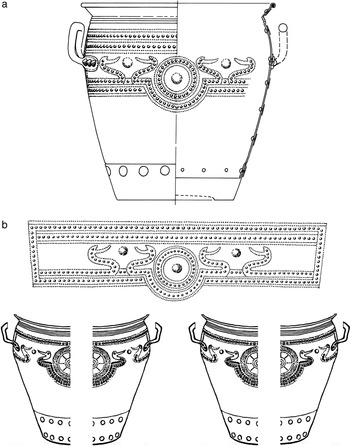
Figure 3.17 Bird-boat design on Hajdúböszörmény-type buckets. a) Hajdúböszörmény, Hajdú-Bihar County, Hungary; b) Schematic illustration of the mimetic object-motif relationship on a bucket from Siem, Rebild Municipality, Denmark. The symmetrical layout of the motif corresponds to the symmetry of the bucket, resulting in four identical sections.

Figure 3.18 Examples of mimetic object-motif relationships on late Early Iron Age lids from Kleinklein, Leibnitz District, Styria, Austria. The bird and solar motifs follow the circular shape of the lids, thus further emphasising notions of cyclical movement. a) Kröll-Schmiedkogel tumulus; b) Pommerkogel tumulus.
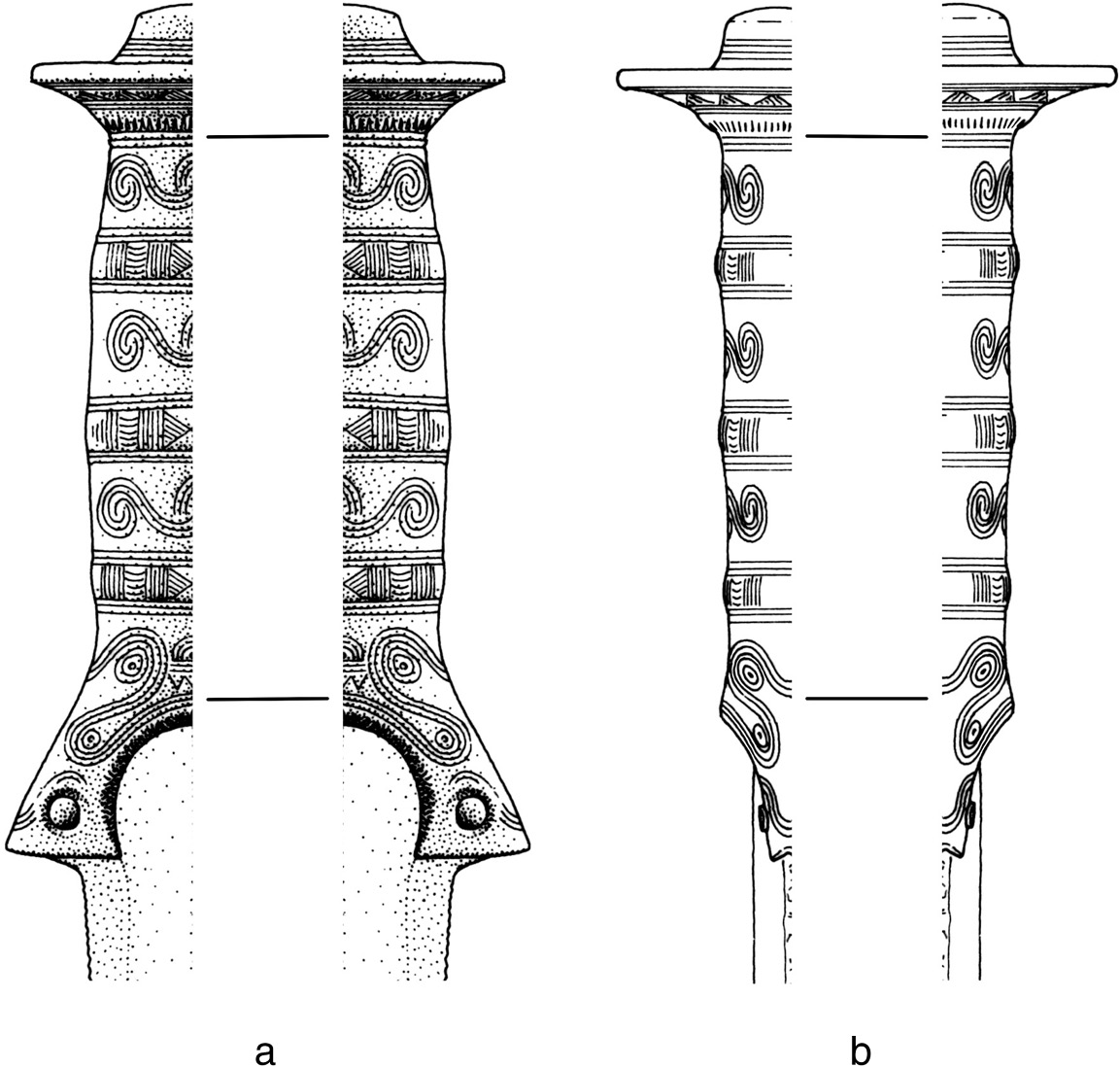
Figure 3.19 Schematic illustration of the symmetrical design on a Dreiwulstschwert from Ehingen, Alb-Donau District, Baden-Württemberg, Germany. a) Front view; b) Side view.

Figure 3.20 Examples of motif animation on wagons. a) One of a pair of linch pins from Bobrovček, Kis Bobrócz District, Slovakia; b) One of four linch pins from the Bullenheimer Berg, Kitzingen District, Bavaria, Germany; c) Cauldron wagon from Acholshausen, Würzburg District, Bavaria, Germany.
This becomes clear when taking a closer look at the positioning of the motif relative to the overall morphology of objects. On a particular type of Late Bronze Age sheet-bronze vessel, known as Hajdúböszörmény bucket (Figure 3.17), named after the eponymous find spot in north-eastern Hungary, the bird-boat motif is punched into the vessel’s surface so as to enhance the symmetrical morphology of the vessel itself. This visual strategy takes place on two levels: first, the arrangement of motifs on either side of the vessel is identical. Second, the intrinsic symmetry of the motif, in turn, visually structures either side into identical panes. The overall visual effect is thus one of a choreographed, mimetic relationship between the vessel and the motif, centred around a symmetrical layout (Figure 3.17b). This design visually epitomised the notion of solar cyclicality expressed at the level of the motif by translating it into a visual property that appears to underlie both the morphology of the vessel and the layout of the motif itself. Intriguingly, however, apart from this symmetrical design, the notion of cyclicality was also emphasised in another way. The linear structure of the motif follows the intrinsic ‘roundness’ of the vessel, thus adding a three-dimensional, spatial dimension to the overall scene. Indeed, it seems as though the bird-boat is circling around the vessel, further cementing the mimetic relationship between vessel and motif.
Thus, the case of Hajdúböszörmény-type vessels illustrates the significance of visual designs in the expression of a cyclical worldview. In fact, what we can see is a deep concern with the visual condensation and replication of religious information through carefully orchestrated motif-object relationships. A symmetrical, linear design and its translation into a three-dimensional perspective were both strategies that visually enacted notions of cyclical movement. This design creatively narrowed the gap between transcendental and immanent temporalities, between the eternity of a cosmological narrative and its materialisation through metalwork.
Interestingly, with slight modifications, elements of this design were still present in the Early Iron Age. A number of ornate bronze lids from the late Early Iron Age cemetery of Kleinklein in Styria, Austria (Figure 3.18), provide a good example. Punched onto the surface of these lids are either bird-boats or full-bodied birds, featuring stylised legs and a tail. The sun, or sun-wheel motifs, invariably occupy a different register. Importantly, however, both sun and bird motifs are arranged so as to follow the inherent roundness of the vessel; as in the case of Late Bronze Age Hajdúböszörmény-type vessels this kind of arrangement creates a visually mimetic relationship between motif and object. In a couple of cases, the visual efficacy of this design was enhanced through the repetition of motif registers, creating a particular kind of visual illusion: when moving one’s sight from the inner centre of the lid to its outer perimeter, or vice versa, one essentially witnesses the same scene again, the difference being that it either narrows or widens. In other words, the repetition of motif registers had the effect of extending/narrowing the overall composition spatially; this visual effect both depended on and emphasised the circular arrangement of the motifs, which in turn mimicked the shape of the lid. Thus, as with Hajdúböszörmény-type vessels we can note a carefully orchestrated relationship between motifs and objects, geared towards the visual summation and emphasis of a cyclical narrative.
Applied to vessels, this strategy of visually epitomising cosmological information was thus part of objects that were communally used and displayed. The occasion of a feast would have provided an ideal setting for both the display and enactment of shared ideologies It is perhaps also no coincidence that the visual strategies outlined above are found on vessels that would have probably been used for the preparation, storage, and consumption of mind-altering (alcoholic) beverages: sensu in vino veritas, as their contents diminished, their visual effects would have become more effective and authentic.
Visual design strategies focused on the creation of mimetic relationships between objects and motifs were not limited to communal items. They are also found on objects with more personal connotations, as is well illustrated with the case of Late Bronze Age swords. The earliest two-dimensional representations of the bird-boat motif are found on a particular type of solid-hilted swords, dating broadly from the middle of the thirteenth to the eleventh centuries bc (Reinecke: Ha A1 – Ha A2) (Figure 3.19). On these so-called Dreiwulstschwertern (solid-hilted swords with three raised ridges on their handle bar) the bird-boat is consistently positioned on the lower section of the hilt, precisely at the point where the blade enters the hilt. This relationship between the motif and the sword recalls some of the design elements that we have already noted for the somewhat later Late Bronze and Early Iron Age vessels. Thus, the intrinsic two-dimensional symmetry of the motif chimes with the symmetrical morphology of the sword. As illustrated in Figure 3.19, if one were to dissect the sword into four identical sections down its vertical axis, one would end up not only with four identical sections of the sword, but also with four identical parts of the bird motif. Importantly, as with Hajdúböszörmény-type vessels, this linear symmetry was transposed onto a three-dimensional pane, thus tracing the intrinsic roundness of the hilt. Again, what we see is a mimetic relationship between motif and object. Compared to vessels, however, there is an important difference: the motif is comparatively small and when the sword is held by its handle, barely noticeable. The emphasis was clearly not on public display. Yet, in spite of this, the relationship between the sword and the motif is visually orchestrated so as to epitomise a cosmological narrative revolving around cyclical movement. Why is this the case? Due to its particular position on the hilt of a sword, the motif not only entered an effective relationship with the visual appearance of the sword but, importantly, it also followed the outline of the human hand which enclosed the hilt. In other words, by i) being positioned on the hilt of the sword, and ii) by following the latter’s shape, the motif also became an extension of the user’s body, for it could be held whenever the sword was used. Thus whilst the visual efficacy of the motif may have been reduced by both its small size and position on the hilt, it was precisely this kind of design which facilitated a more personalised engagement with the narrative: quite literally, to hold the sword was to clasp the narrative.
In conclusion, the design choices which I have referred to in terms of epitomic visualisation constituted a creative strategy of presencing cosmological principles by emphasising them visually. On the one hand, the creation of this visual effect depended on the use of a linear symmetrical design, which in its two-dimensional format (as the bird-boat) represented a visually economical, and thus mnemonically effective way of representing cyclical movement. On the other hand, however, it was only by coupling the motif’s linear symmetry with both the symmetrical morphology and roundness of the respective objects that it became visually effective. Creative design transformed objects into micro-cosmos that visually and (as in the case of swords) physically enacted a cyclical narrative. It is the physical dimension of this design to which I shall now turn.
Designs of Movements and Animated Motifs
Whilst vision plays an important role in how we perceive our surroundings, we experience the world with more than one sense (Hegel Reference Hegel2007; Merleau-Ponty Reference Merleau-Ponty1962). Religious material culture engages several of our senses at the same time and thus creates a state in which religious knowledge can be experienced holistically through bodily perception (Sobchack Reference Sobchack2008). That is also true of metalwork with Bronze Age bird imagery.
As shown in the previous section, bird images materialised a cyclical worldview through a visual design that choreographed the relationship between objects and their imagery. In the case of vessels this design would have optimised the comprehension of religious information during communal rituals. In the case of swords, the same kind of design would have facilitated the incorporation of human movement into the narrative, thus forging a close link between an individual’s visual and tactile perception. In that way, the design of images and objects allowed people to animate and experience part of the narrative.
This point can be further illustrated with a couple of examples: first, the use of bird images on wagons, and second, their use as personal ornaments. Within these two categories, the relationship between motifs and objects was designed so as to incorporate human-centred movement, thus making it possible to physically animate and emphasise certain aspects of Bronze Age cosmology.
The recurrent association between bird images and Late Bronze Age wagons has long been noted for central and eastern Europe (Müller-Karpe Reference Müller-Karpe1955; Pare Reference Pare and Barth1987a and Reference Pareb, Reference Pare1989; Reim Reference Reim1981; Winghart Reference Winghart, Dannheimer and Gebhard1993, Reference Winghart1999: 521, fig. 4, 524, fig. 8), and it has been suggested that the ancient Near East may have provided an initial stimulus for its development; for here birds and wagons played an important role in the death rites of the Hittites and other civilisations (Schauer Reference Schauer, Barth, Biel, Egg, France-Lanord, Joachim, Pare, Schauer and Uenz1987). While the possibility of such intercultural connections is difficult to assess, the combination of bird representations and Late Bronze Age wagons is a characteristic feature of a number of Late Bronze Age cremation burials in central Europe, known as the Hart an der Alz group (Müller-Karpe Reference Müller-Karpe1955; Winghart Reference Winghart1999).
In terms of metalwork, the association of bird images with wagons falls into two main categories: on the one hand, bird representations occur three-dimensionally on wagons, either in the form of small figurines attached to the vehicle’s outer frame, sockets or linch pins; on the other hand, and less frequently, they form part of miniature or so-called cult wagons, which contained cremated remains or other, presumably, feasting-related substances. It was within these two categories that religious ideas revolving around movement could be dramaturgically enacted.
As for the first category – the occurrence of bird appliqués on ceremonial wagons – the bird-shaped linch pins shown in Figure 3.20 (a and b) provide a good illustration. Here the recurrent association of bird and sun/wheel motifs has been translated into a three-dimensional format that could be brought into motion by using the wagon. This was possible because, syntactically, the wheels of the wagon formed part of the motif composition, being a three-dimensional rendition of the sun/sun-wheel motif. Thus, as in the case of solid-hilted swords discussed above, we can note the presence of a mimetic relationship between the functionality of the object and the physical animation of the scene: the use of the wagon brought the motifs into motion. In the case of the linch pins from the site of Bullenheimer Berg, in southern Germany (Figure 3.20b), the bird would have been perceived against the background of a spinning wheel when the wagon was used. A similar design can be noted for the bird-shaped linch pins from Bobrovček, Slovakia (Figure 3.20a), but here the effects of visually animating the scene would have been amplified acoustically through the clinking noise created by the rings inserted through the birds’ beaks. Thus, cosmological notions of cyclical movement were dramaturgically enacted through physical movement and sound.
Perhaps the most illustrative example of such animated design comes in the form of miniature wagons, such as that from Acholshausen, southern Germany (Figure 3.20c) (Pescheck Reference Pescheck1972). With a length of around 18 cm the wagon is essentially a three-dimensional version of the classic bird-boat motif, consisting of two pairs of antithetical bird protomes and a central ‘sun’ motif in the form of an ornately decorated bronze cauldron. In taking this form, the motif could be moved, thus animated through human agency at significant occasions, in this case the burial of a social elite. Mnemonically, it facilitated the dramaturgical performance of ideological information through physical movement.
Thus the combination of bird representations and wagons can be seen as a creative solution to the theological challenge of presencing notions of cosmological, eternal movement materially in the here and now. Through a design that integrated bird images into the functionality of wagons (i.e. into their movement), it became possible to create a mimetic relationship between physical and cosmological movement. In other words, on wagons, bird images materialised notions of cosmological movement visually and acoustically. In socio-ideological terms, this was a design that allowed certain individuals to control the presence of the divine, by materially animating it at socio-culturally significant occasions in public display.
A similar strategy of materialising movement through objects can be noted for a range of body ornaments, such as Late Bronze Age fibulae and pendants. The objects depicted in Figure 3.21 feature three-dimensional bird representations which are combined with various types of sheet-metal pendants. When worn on the body – in their function as fibulae or pendants – such ornaments create a jingling sound. Thus, as with the combination of birds and wagons, movement resulted in the acoustic animation of the scene. In the case of fibulae and pendants, however, the movement required for this kind of animation was directly related to the action and gestures of an individual’s body. The materialisation of cosmological movement became both activated and channelled through the human body, thus anchoring religious knowledge to corporeal perfomativity and self-awareness. Indeed, what I have referred in terms of a mimetic or choreographed relationship between motif and object, became extended to the kinaesthetic identity of the wearer: a design that facilitated the fusion or co-presence of corporeal and cosmological movement through sensory experience.
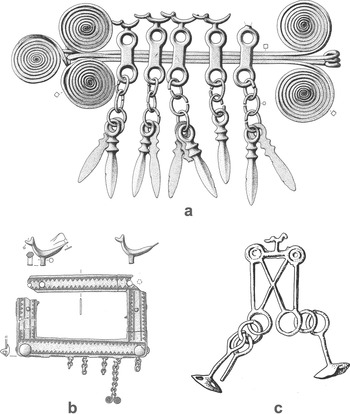
Figure 3.21 Examples of motif animation on bird-shaped ornaments. a) Opava-Kateřinky, Opava District, Czech Republic; b) Veliki Mošunj, Town and Municipality of Vitež, Central Bosnia Canton, Bosnia and Herzegovina; c) Bingula-Divoš, Šid Municipality, Srem District, Autonomous Province of Vojvodina, Serbia.
Conclusion: Creativity as Sensual Cosmology
Thus, the case of Late Bronze Age bird imagery suggests that creativity was intrinsic to the materialisation of Bronze Age cosmologies. Bird representations stimulated people’s sensory awareness of a core narrative, centred on notions of cyclical movement. That was achieved through a design that synchronised the relationship between information expressed at the level of motifs and people’s perception of objects. In that way, bird imagery not only presented core elements of a cyclical worldview, it also integrated them into the design of metalwork and people’s experience of it.
This essay suggested that this process took two main forms, one of which aimed at the visual condensation of cosmological information, the other of which focused on the physical and acoustic animation of motifs through human agency. Following either design, bird representations did not just reflect a cosmology of cyclical movement; rather they articulated it through objects so that people could perceive and, in certain cases, enact notions of cyclicality. The result was a material universe which fused the material with the immaterial, the abstract with the experiential. In other words, creativity as sensual cosmology.

